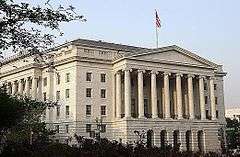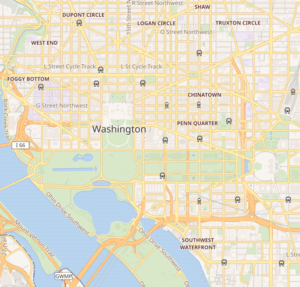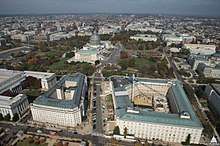Longworth House Office Building
The Longworth House Office Building (LHOB) is one of three office buildings used by the United States House of Representatives. The building is located south of the Capitol, bounded by Independence Avenue, New Jersey Avenue, C Street S.E., and South Capitol Street, in southeast Washington. It covers an area of 599,675 square feet (55,711.6 m2) and has a total of 251 congressional offices and suites, five large committee rooms, seven small committee rooms, and a large assembly room now used by the Ways and Means Committee.
| Longworth House Office Building | |
|---|---|
 The Longworth House Office Building | |
 Location within Washington, D.C. | |
| General information | |
| Status | Complete |
| Architectural style | Neoclassical |
| Location | United States Capitol Complex |
| Town or city | Washington, D.C. |
| Country | United States |
| Coordinates | 38°53′12.48″N 77°0′30.6″W |
| Opened | April 1933 |
| Technical details | |
| Material | Marble |
| Grounds | 702,608 square feet (65,274.4 m2) |
| Design and construction | |
| Architect | Frank Upman, Gilbert LaCoste Rodier, Nathan C. Wyeth and Louis Justemente |
| Architecture firm | Allied Architects of Washington |
The building was named in 1962 in honor of the former Speaker of the House, Nicholas Longworth of Ohio. He served as Speaker from 1925 until Republicans lost their majority in 1931, the same year he died, and the same year the building was authorized.
History

Plans to provide the House of Representatives with a second office building were begun in 1925. Severe overcrowding in the Cannon House Office Building (completed in 1908) led to the renovation of the Cannon Building and the construction of the Longworth Building".[1] It is the smallest House office building, with a floor area of just under 600,000 square feet (56,000 m2). Under the direction of Architect of the Capitol David Lynn, preliminary designs for the building were prepared by a local firm known as The Allied Architects of Washington Inc. The principal architects were Frank Upman, Gilbert LaCoste Rodier, Nathan C. Wyeth, and Louis Justemente. They produced "two schemes for a simple, dignified building in harmony with the rest of the Capitol Complex. In January 1929 Congress authorized $8.4 million for acquiring and clearing the site and for constructing the new building. The foundations were completed in December 1930, and the building was accepted for occupancy in April 1933".[1]
The large assembly room of the Longworth Building, which seats 450 people, was used by the House of Representatives as their primary meeting room in 1949 and 1950 while its chamber in the United States Capitol was being remodeled. It is currently the meeting room for the House Ways and Means Committee. In the 1960s, the House Beauty Shop, a salon which catered to Congresspersons, their spouses, and employees, was relocated to the Cannon House Office Building from the smaller Longworth House Office Building under the auspices of the Beauty Shop Committee.[2]
"Because of its position on a sloping site, the rusticated base of the Longworth Building varies in height from two to four stories. Above this granite base stand the three principal floors, which are faced with white marble. Ionic columns supporting a well-proportioned entablature are used for the building's five porticoes, the principal one of which is topped by a pediment. Two additional stories are partially hidden by a marble balustrade. It presents a somewhat more restrained appearance than the neighboring Cannon Building, which was designed in the more theatrical Beaux Arts style. The Longworth Building takes its place along with the National Gallery of Art (1941) and the Jefferson Memorial (1943) as one of Washington's best examples of the Neo-classical Revival style".[1]
References
- "Architect of the Capitol: Longworth House Office Building". Retrieved 2012-05-29.
- "Wash, Rinse, and Equal Treatment". United States House of Representatives Archives. 2016-10-24. Retrieved 2020-01-10.
External links
- Three Bits of Trivia About the Longworth House Office Building - Ghosts of DC blog post
- 3D SketchUp model of the Longworth House Office Building for use in Google Earth